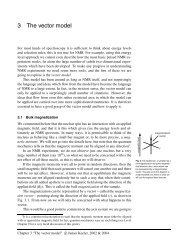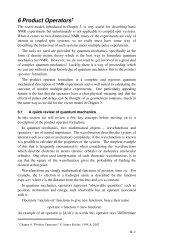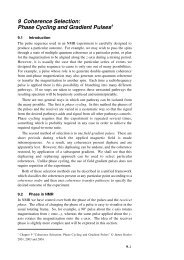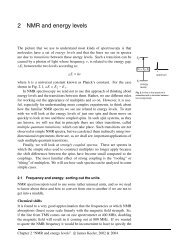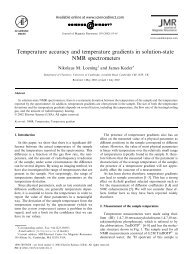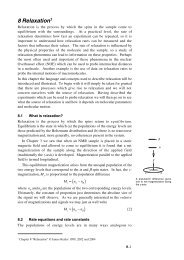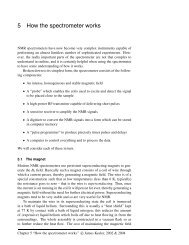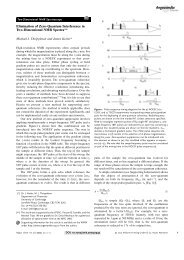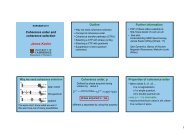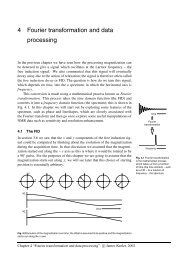Phase Cycling and Gradient Pulses - The James Keeler Group
Phase Cycling and Gradient Pulses - The James Keeler Group
Phase Cycling and Gradient Pulses - The James Keeler Group
You also want an ePaper? Increase the reach of your titles
YUMPU automatically turns print PDFs into web optimized ePapers that Google loves.
stronger the gradient the more rapidly the phase varies across the sample <strong>and</strong><br />
thus the more rapidly the echo will be attenuated. This is the physical<br />
2 2 2<br />
interpretation of the term γ G τ in Eqn. [15].<br />
Diffusion constants generally decrease as the molecular mass increases. A<br />
small molecule, such as water, will diffuse up to twenty times faster than a<br />
protein with molecular weight 20,000. <strong>The</strong> table shows the loss in intensity due<br />
to diffusion for typical gradient pulse pair of 2 ms duration <strong>and</strong> of strength 10 G<br />
cm –1 for a small, medium <strong>and</strong> large sized molecule; data is given for ∆ = 2 ms<br />
<strong>and</strong> ∆ = 100 ms. It is seen that even for the most rapidly diffusing molecules<br />
the loss of intensity is rather small for ∆ = 2 ms, but becomes significant for<br />
longer delays. For large molecules, the effect is small in all cases.<br />
Fraction of transverse magnetization refocused after a spin echo with gradient refocusing a<br />
∆/ms small molecule b medium sized molecule c macro molecule d<br />
2 0.99 1.00 1.00<br />
100 0.55 0.88 0.97<br />
a<br />
Calculated for the pulse sequence shown above for two gradients of strength 10 G cm –1 <strong>and</strong><br />
duration, τ, 2 ms; relaxation is ignored. b Diffusion constant, D, taken as that for water, which<br />
is 2.1 × 10 –9 m 2 s –1 at ambient temperatures. c Diffusion constant taken as 0.46 × 10 –9 m 2 s –1 .<br />
d<br />
Diffusion constant taken as 0.12 × 10 –9 m 2 s –1 .<br />
9.6.6.1 Minimisation of Diffusion Losses<br />
<strong>The</strong> foregoing discussion makes it clear that in order to minimise intensity<br />
losses due to diffusion the product of the strength <strong>and</strong> durations of the gradient<br />
pulses, G 2 τ 2 , should be kept as small as is consistent with achieving the<br />
required level of suppression. In addition, a gradient pulse pair should be<br />
separated by the shortest time, ∆, within the limits imposed by the pulse<br />
sequence. This condition applies to gradient pairs the first of which is<br />
responsible for dephasing, <strong>and</strong> the second for rephasing. Once the coherence is<br />
rephased the time that elapses before further gradient pairs is irrelevant from<br />
the point of view of diffusion losses.<br />
In two-dimensional NMR, diffusion can lead to line broadening in the F 1<br />
dimension if t 1<br />
intervenes between a gradient pair. Consider the two alternative<br />
pulse sequences for recording a simple COSY spectrum shown opposite. In (a)<br />
the gradient pair are separated by the very short time of the final pulse, thus<br />
keeping the diffusion induced losses to an absolute minimum. In (b) the two<br />
gradients are separated by the incrementable time t 1<br />
; as this increases the losses<br />
due to diffusion will also increase, resulting in an extra decay of the signal in t 1<br />
.<br />
<strong>The</strong> extra line broadening due to this decay can be estimated from Eqn. [15],<br />
2 2 2<br />
with ∆ = t 1<br />
, as γ G τ D π Hz. For a pair of 2 ms gradients of strength 10 G<br />
cm –1 this amounts ≈ 2 Hz in the case of a small molecule.<br />
This effect by which diffusion causes an extra line broadening in the F 1<br />
dimension is usually described as diffusion weighting. Generally it is possible<br />
to avoid it by careful placing of the gradients. For example, the sequences (a)<br />
9–43<br />
(a)<br />
RF<br />
g<br />
(b)<br />
RF<br />
g<br />
t 1<br />
t 2<br />
t 1<br />
t 2



